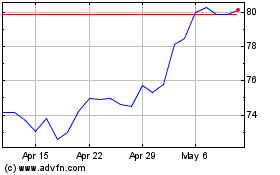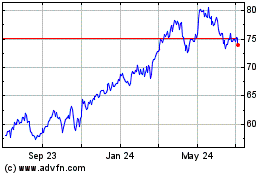As MetLife Zigs, AIG Zags
January 27 2016 - 3:02AM
Dow Jones News
(FROM THE WALL STREET JOURNAL 1/27/16)
By Ryan Tracy
American International Group Inc.'s move to pare down its
operations looked like a baby step compared with recent moves by
other nonbank financial institutions branded systemically important
by regulators.
While MetLife Inc. this month cited the new regulatory burden as
a central reason for it to seek to divest one of its core
businesses, AIG made the case that even with the stricter rules
that come with its size, its whole is greater than the sum of its
parts. AIG is one of four nonbank financial firms labeled as
systemically important financial institutions, or SIFI.
"Near-term breakup of AIG would detract from shareholder value,"
the company said in its investor presentation Tuesday.
AIG also said it "has a lower risk profile than other nonbank
SIFIs across key metrics," citing data showing that it has fewer
assets and funds itself with less borrowing compared with
Prudential Financial Inc. and MetLife, two other firms that have
received the SIFI tag.
That suggests that AIG may believe it won't face as high a
regulatory burden as those firms. Federal regulations are generally
tailored to a firm's riskiness, but regulations for insurance
companies labeled as systemically important haven't been written
yet.
Douglas Steenland, AIG's nonexecutive chairman, said the board
has "full support for the plans that [CEO] Peter Hancock and his
management team have put forward."
Some of AIG's shareholders have been arguing that the company
would be worth more if it was split into parts, each of which could
shed the stricter regulations that come with being big.
Indeed, other institutions have reached that conclusion, and
their reactions to being labeled systemically important have been
more drastic.
General Electric Co.'s finance arm, GE Capital, is shrinking its
assets even more significantly and has said it would seek to get
the systemically important label repealed this year.
No company has yet succeeded in having the label removed,
although MetLife is fighting it in court. AIG might have a harder
time succeeding in that task, given the central role that AIG
played in the financial crisis.
For now, AIG's management appears focused on restructuring
itself. The company also appeared to position itself to shrink
further in the future if results don't meet expectations, namely by
reorganizing into nine separate business units.
That could make those divisions easier to divest, and it could
also help AIG with certain regulatory demands. For instance, it
might have an easier time demonstrating that it has a credible
"living will" bankruptcy plan with regulators if it could easily
sell certain businesses to raise cash in a pinch.
(END) Dow Jones Newswires
January 27, 2016 02:47 ET (07:47 GMT)
Copyright (c) 2016 Dow Jones & Company, Inc.
American (NYSE:AIG)
Historical Stock Chart
From Mar 2024 to Apr 2024

American (NYSE:AIG)
Historical Stock Chart
From Apr 2023 to Apr 2024
